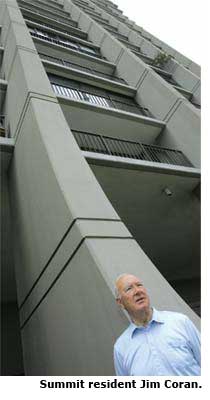The Summit (a.k.a. the Eichler Summit) - Page 3
Gomez says the Summit has retained its appeal over the years, even as the city filled with new condo towers, often with more amenities—including exercise rooms, more common spaces, and pools. "It's always been highly regarded. That building is known for having very high quality management and a very competent homeowners association," Gomez says. "It's perceived in the community as a well-run building."
There is much to like about the Summit, even beyond its views. Its location is perfect for fans of city living, residents say. Nelson-Rees and Coran enjoy walking to the theater and other cultural events. This is very much a pedestrian-oriented community, with many residents walking the steep slopes to North Beach, the Wharf, or Nob Hill, each only minutes away.
The steepness adds to the buildings appeal, to some. "That's one of the things I like about the place," Long says. "I get my exercise." Walls between units are solid, residents say, so the building is quiet. "We do hear every fire engine in town," Coran observes.
The biggest complaint? The lack of a freight elevator, which is especially troublesome on days—most days, it seems—when someone is using one of the two passenger elevators for a remodeling job. "They call it Home Depot around here," Nelson-Rees says. "Material goes up, material goes down. An old toilet goes out, a new toilet goes in." Waits for the one-remaining elevator can be long.
Architect Tibor Fecskes, who designed the Summit while working for Neill Smith & Associates, says Eichler never asked for a service elevator—though he kept an eagle eye on the project from an apartment he rented nearby for that purpose. "I think it was on the fifth or sixth or seventh floor," says Fecskes, 87, who lives in Sausalito, where pictures of the Summit still decorate his studio. "In the corner window he [Eichler] set up his binoculars to watch the construction. Over the phone he was communicating with the construction manager. He really wanted to build something significant," Fecskes recalls.
Eichler chose a prominent site on the summit of Russian Hill, which was occupied by a house designed by Julia Morgan. The owner was Neill Smith, who sold it to Eichler with the proviso that his firm would do the design. Soon, Fecskes said, the design work fell to him. The Summit became the only Eichler neighborhood that was not primarily designed by one of Eichler's regular teams of architects. Claude Oakland, whose firm was relegated to the interior appointments, didn't mind the arrangement, says Fecskes, who knew Oakland.

Soon, working with structural engineer Steven Medvedowsky, Fecskes was designing a reinforced concrete tower whose post-tensioned concrete slab floors cantilevered from a central core and were further supported by piers that swoop up from the ground in the shape of a catenary curve. (To get a catenary curve, tack two pins to the wall at an equal height and suspend a chain between them.) "What is the most beautiful curvature? Obviously, the gravity curve," Fecskes says. "You cannot beat it, and all the curvatures in the building are like that."
Another unusual facet of the design is, each floor above the 24th cantilevers out just a foot further than the one below. The result is added square footage—and added value. "It's very unusual," Fecskes says. "It works against perspective. You look up at a building, it's usually tapering."
Fecskes came to admire Eichler, whom he met virtually every day during design and construction, and believes the feeling was mutual. "He was the really rare developer who respected professionals, and was seeking out their advice," Fecskes says. "This is such an obvious and intelligent way to operate for a general who is in charge, and makes the decisions."
Fecskes remembers watching Eichler negotiate over the phone for the window walls that would clothe the Summit. "When he got a quote from one company, he said, 'Wait a minute.' Then he called the other company. He told them the offer. 'Can you beat it?' So he arrived at a lower bid. That was the manner he operated. Very smart."
The Summit provoked much controversy during the '60s because of its height, in a historic district primarily of single-family homes and smaller apartment buildings. Objections by neighbors to the Summit, and to other proposed high rises both on Russian Hill and elsewhere in the city, convinced the Board of Supervisors in 1972 to reduce height limits throughout much of the city.
Apartments in the new luxury high rise sold quickly, says Eichler's longtime sales associate Catherine Munson, who'd had more experience marketing middle-class homes in the suburbs. She didn't alter her sales methods, Munson recalls, but adds: "I did buy better clothing to wear. It's the city. You have to be more dressed up."
"The exterior appearance was very important," she says. "That gorgeous structural element was stunning. It really caught people's eyes."




